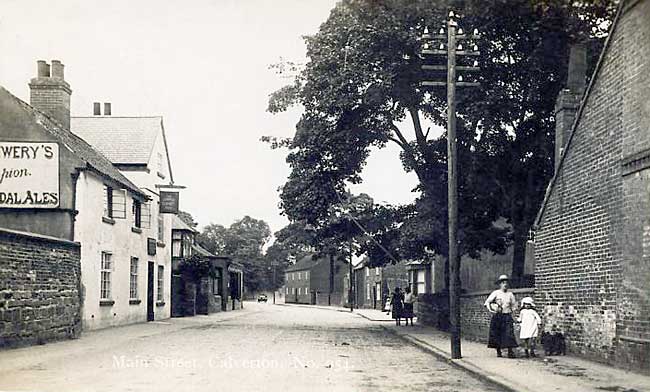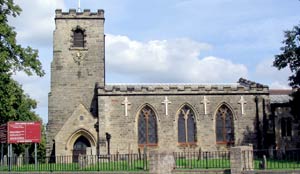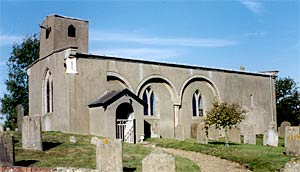< Previous | Contents | Next >
William Lee

Main Street, Calverton, in the 1920s.
CALVERTON. An old village straggling along at the foot of friendly hills (now being developed by a colliery and a housing estate), Calverton is remembered for its association with a man who died in poverty though he made many rich. He was William Lee, whose epoch-making stocking-frame brought him disappointment and a broken heart.
Though it is generally accepted that he was born here, some claim Woodborough as his birthplace. There is some uncertainty, too, as to whether it was of Calverton or Woodborough that he became curate after taking his degree as Master of Arts of Cambridge. And whether, his invention was cradled in romance or in dire necessity depends on which of two stories we believe to be true—one telling how the constant knitting of a lady indifferent to his wooing drove him to the creation of a machine to take the place of her needles; the other how the poor curate found his inspiration in watching the nimble fingers of his wife whose knitting eked out his scanty income.
After working here with his wooden frame for about two years, using rough tools and wool spun from the backs of local sheep, Lee sought the patronage of Queen Elizabeth, who saw the frame at work but, disappointed that it did not make silk stockings, refused to grant a patent. Then the inventive parson made the frame produce silk stockings as easily as woollen, but the queen, fearing that it would throw the hand-knitters out of work, again refused a patent.
Through the mediation of the French Ambassador, Lee in his despair accepted the invitation of Henry the Fourth to France, and, with the help of his brother James and a few workmen, set up the frame at Rouen. There the help promised him did not materialise owing to the king's assassination, and Lee was left penniless in Paris, where he died about 1610 and was buried in an unknown grave. The frame was brought back to London, and eventually hosiery became a staple industry of Lee's own county.
His lasting memorial is in the great power machines which knit and make lace for the world today, for they had their beginning in his stocking-frame, one of the most astonishingly complete inventions ever devised at a single operation, and the first machine ever made to produce a looped or knitted fabric. Power machines are making hosiery in Calverton now, but we are back in the days of William Lee as we listen even yet to the rattle of the hand-frames in some of the cottages with wide windows, where globes of water are hung by the frames to catch the light and throw its beams on to the needles. His only actual memorial here is an addition made to the village school. In one of these cottages there died in 1938 an old man who kept in his home some of the original stocking-frames of William Lee, on one of which is the mark of a bomb thrown in the Luddite riots.

Calverton church in 2005.
The church came into Domesday Book, but only a few things are left of ancient days. The church the Normans left was made new in the 14th century and again in the 18th. Fragments of Norman moulding are in the north wall: the sides of the chancel arch are Norman, and on one of the capitals is a tiny panel carved with two figures believed to be St Wilfrid and a convert.
Built into the belfry are seven stones carved by a Norman mason to illustrate the occupations of the months. January is represented by a man sitting at a table laden with food, while his hawk looks on; February is a man in a tunic, cloak, and heavy boots, warming himself at a fire under a tree; for March or April a man is pruning a tree with a big knife; another in June seems to be hoeing among growing crops; August is a man in a big hat, reaping corn with a sickle; and two panels represent September with two men threshing corn with flails. An eighth stone has a man on horseback with his hawk on his wrist, and a dog with tufted tail holding a hare or a rabbit.
Between the Parks

Carburton church in 2000.
CARBURTON. Its old church is outlined on the rising slope, and it has a lovely view between the gracious parks of Welbeck and Clumber.
Side by side through the village run the road and the little River Poulter till they enter Clumber Park, where one goes to feed a great lake of nearly 90 acres, and the other to find the magnificent Duke's Drive, which stretches, with a double row of limes on each side, for three miles to Apleyhead, It is a splendid ride which all may take.
A busy little river is the Poulter, though placid enough as it flows through the village. It feeds the lake at Welbeck as well as that of Clumber, and the fine stretches known as Carburton Forge Dam and Carburton Dam remind us of the days when it worked an iron forge here, the iron being brought from Derbyshire and smelted by charcoal.
In a churchyard bounded by the Flood Dyke is the small chapel of Norman foundation, with nave and chancel under one roof, a square bell turret at one end, and a little porch: quaint in its simplicity, but, like the poet's old thatched cottage, wondrous neat and clean. A plain Norman doorway lets us in, and three tiny Norman windows are still here, a 13th century lancet between two of them in the east wall. The west window is 600 years old, and the tub font is Norman. There is a double sundial on a corner of the church, and just inside the door is part of an ancient gravestone.
The rare possession of the church is a register dating from 1528, said to be one of only three existing of this time. A second is at Perlethorpe three miles away, and the third is at Elsworth in Cambridgeshire. The date from which registers were kept by order of Thomas Cromwell was 1538, so that these three are ten years older than the oldest official record.
